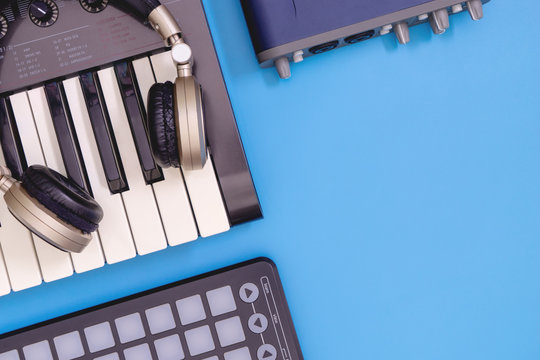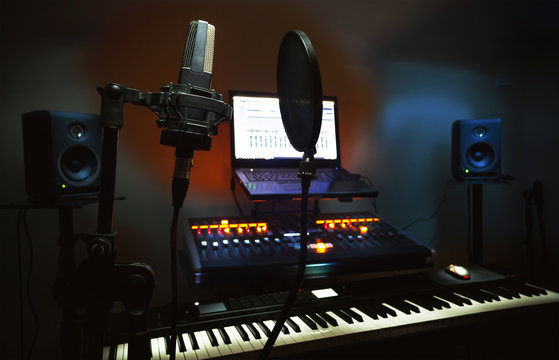Are you a music producer who’s always on the go? Do you want to create top-notch tracks without lugging around heavy equipment? Look no further than your trusty MacBook Air. With the right tips and tricks, you can turn your portable device into a powerhouse for music production. In this blog post, we’ll explore how to master music production on MacBook Air and create professional-grade tracks from anywhere. Whether you’re a seasoned producer or just starting out, these tips will take your music to the next level.

Why MacBook Air is the Perfect Tool for Music Production
MacBook Air is becoming a popular tool for music production. It is lightweight, portable, and powerful enough to handle most music production tasks. With Apple’s hardware and software integration, MacBook Air provides an excellent environment for creating professional-grade music.
One of the main reasons why MacBook Air is well-suited for music production is its fast SSD storage, which allows users to load large files quickly. Moreover, it has up to 16GB RAM and Intel Core processors that can support multiple plugins and tracks simultaneously without any lag or latency issues.
Additionally, the latest versions of Apple’s macOS operating system offer enhanced features such as optimized power consumption and improved audio drivers that provide better performance in recording & playback sessions.
Overall, if you’re looking for a reliable device that doesn’t compromise on quality but still remains portable enough; then MacBook Air should be your go-to option for Music Production.

Essential Software and Tools for Music Production on MacBook Air
GarageBand and Logic Pro X are two of the most essential and powerful software tools for music production on MacBook Air. GarageBand comes pre-installed on all MacBook Air devices, making it a convenient option for those just starting out in music production. It offers basic features such as recording, editing, mixing, and even has a selection of virtual instruments to choose from.
For more advanced users looking to take their music production skills to the next level, Logic Pro X is the perfect tool. This professional-grade digital audio workstation allows for complete control over every aspect of your music, from recording and editing to mixing and mastering.
In addition to software tools, having quality hardware accessories can also improve your overall experience with music production on MacBook Air. A high-quality microphone or headphones can make all the difference when it comes to capturing great sound recordings or hearing subtle nuances in your tracks during playback.
Overall, investing in both key software tools like GarageBand and Logic Pro X along with complementary hardware accessories will help optimize your music production capabilities on MacBook Air.

Tips for Optimizing Your MacBook Air for Music Production
Optimizing Your MacBook Air for Music Production
If you want to get the most out of your MacBook Air for music production, there are a few things you can do to optimize its performance. First, make sure you have enough storage space for all your music files and software. Consider using an external hard drive or cloud storage to free up space on your laptop.
Second, increase your RAM if possible. This will allow your MacBook Air to handle more complex projects without slowing down. You can also close unnecessary applications and processes while working on music production to free up memory and processing power.
Third, use an external audio interface for better sound quality and lower latency. This will help reduce the risk of audio dropouts or glitches during recording or playback.
Finally, keep your MacBook Air clean and cool by regularly cleaning the keyboard and fans, and avoiding working in direct sunlight or hot environments. Overheating can cause performance issues and potentially damage your laptop. By following these tips, you can ensure that your MacBook Air is optimized for music production and ready to handle any project you throw at it.
Advanced Techniques for Mixing and Mastering Music on MacBook Air
Utilizing Plugins and Effects to Enhance Your Audio
When it comes to music production on MacBook Air, one of the essential aspects is using plugins and effects to enhance your audio. There are a variety of plugins available that can help you achieve the desired sound, from EQ and compression to reverb and delay. One important tip for utilizing these tools effectively is to use them in moderation, as too much processing can ruin the natural character of your recording. Additionally, don’t be afraid to experiment with different combinations of plugins and effects until you find what works best for your specific project. With some practice and patience, mastering audio with plugins on MacBook Air can take your music production skills to the next level!
Techniques for Mastering Your Music with Precision
To achieve a professional sound in music production on MacBook Air, mastering is essential. One technique is to use the EQ (Equalizer) tool to balance frequencies and eliminate any unwanted frequencies that may be present in your mix. Another key technique is compression, which can help even out volume levels between different parts of your track while adding warmth and character. Don’t forget about stereo widening, which creates a wider soundstage by spreading audio across the stereo field. Lastly, using limiters can prevent clipping or distortion during playback while increasing overall loudness of your track. With these techniques, you can bring your music production on MacBook Air to the next level with precise and polished results.
Troubleshooting Common Issues in Music Production on MacBook Air
As with any technology, there may be some common issues that arise when using your MacBook Air for music production. One issue that many users face is latency, which can cause a delay between the time you play a note and the time it is heard through your speakers. To reduce latency, try increasing your buffer size in your audio interface settings.
Another issue is CPU overload, which can cause your computer to freeze or crash. To avoid this, make sure to close any unnecessary applications and plugins while working on music production. You can also try freezing tracks or bouncing them to audio to reduce the strain on your CPU.
If you are experiencing glitches or errors while recording or playing back audio, try resetting your audio preferences in your DAW or updating your software to the latest version. It’s also important to make sure that all of your equipment is properly connected and configured.
By troubleshooting these common issues, you can ensure a smooth and efficient music production process on your MacBook Air.

Taking Your Music Production to the Next Level with MacBook Air
One of the great things about using a MacBook Air for music production is its portability. You can take your projects with you wherever you go, and work on them whenever inspiration strikes. But there are also ways to take your music production skills to new heights using this powerful machine.
If you want to elevate your music production, consider investing in some hardware that can connect directly to your MacBook Air. For example, a USB audio interface provides better sound quality and more inputs/outputs than the built-in microphone and headphone jacks.
Additionally, learning how to use advanced software tools like Logic Pro X or Ableton Live can open up even more possibilities for creating unique sounds and effects. There are plenty of online tutorials available that can help you master these programs.
Finally, don’t forget about collaboration! With the ability to easily share files through cloud storage services like Dropbox or Google Drive, collaborating with other musicians has never been easier. This opens up opportunities for feedback from others who may have different perspectives on your work, leading to new ideas and collaborations down the line.
With practice, persistence, and some extra investments in hardware/software when necessary – anyone can become an expert at music production using their trusty MacBook Air.
In conclusion, mastering music production on MacBook Air is not only possible but also highly efficient. With the right software and tools, along with some optimization tips, you can record, edit, mix, and master your music with ease. Whether you’re a beginner or an experienced producer, MacBook Air is the perfect tool for unleashing your creativity and taking your music production to the next level.
We hope this article has been helpful in providing you with valuable insights and tips for music production on MacBook Air. If you want to learn more about music production or other related topics, be sure to check out our other content. Keep creating great music!
Q & A
Who uses MacBook Air for music production?
Music producers who need a portable setup.
What software is best for music production on MacBook Air?
Logic Pro X is a popular choice.
How much storage do I need for music production on MacBook Air?
Aim for at least 256GB to store your projects.
But isn’t MacBook Air too weak for music production?
The latest models are powerful enough for most tasks.
What accessories do I need for music production on MacBook Air?
A good pair of headphones and an audio interface.
How can I optimize my MacBook Air for music production?
Close unnecessary apps and use an SSD for faster performance.


